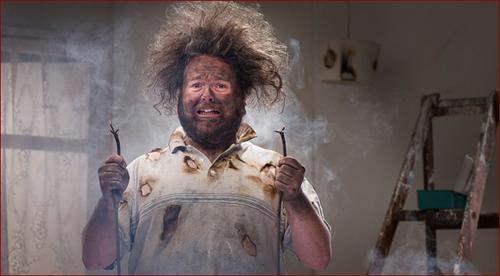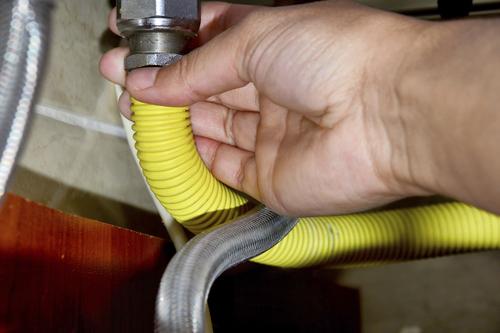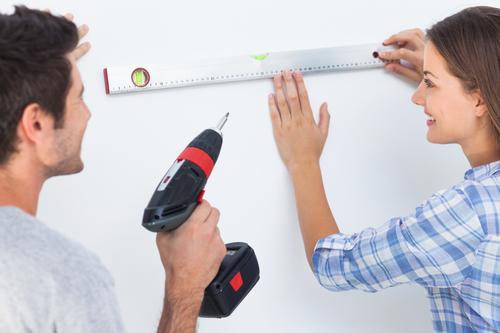Uh Oh… Costly DIY Mistakes You
Really Want to Avoid

(source: http://www.domesticcleaningtips.co.uk/are-you-making-these-costly-diy-mistakes/)
We’ve all been there. Since the dawn of home renovation TV, we’ve come to consider ourselves DIY experts. With designers showing us how to repaint, rewire, remodel, and revamp a room in 48 hours, what could go wrong?
Well…lots. Consider the time my father decided to rewire a ceiling light fixture. This simple project began well, but when it was time to go into the attic to move the electrical wire things took a turn for the worse. Next thing I know, his foot (and ankle and knee) were all coming through my ceiling. Lesson learned. Not everyone is good at this stuff!
So what do contractors say are the most common and most costly DIY mistakes?
1. NOT KNOWING YOUR LIMITS
Know what you’re capable of and know what you’re good at. Sure, we all have our special skills, maybe you fancy yourself the guru of grout or the prince of paint. Kayleen McCabe of DIY Network’s “Rescue Renovation” advises that homeowners should know their limits. She warns, “I come across homeowners constantly who are in the eye of the hurricane and cannot see the chaos around them.”
If you find yourself obsessively searching for “How To” YouTube videos mid-DIY project, you might want to step back from the computer and pick up the phone to hire a contractor.
However, if you’re an experienced DIYer with a handful of confidence, McCabe says there are a lot of jobs that ANY homeowner can do. For example, she encourages homeowners to change a toilet or replace water supply lines. But if you’re contemplating running an entire new water line or moving a toilet to a different location within a bathroom, it’s best to call a plumber. If your plumbing vents aren’t correct, you could have a lifetime of gurgling noises and strange smells coming from your bathtub and sink.
When in doubt, call the professionals. It’s their job!
2. IGNORING MOISTURE ISSUES

(Thinkstock)
Finishing your subterranean spaces without addressing moisture issues is one of the costliest mistakes. Water damage won’t only wreak havoc with your walls, but flooding can ruin your newly-laid carpets or hard wood floors. The Handyguys Brian and Paul say it’s easy to prevent 80-90% of water leaks in your basement by ensuring a few simple things are correct:
-Check that your gutters and downspouts aren’t draining too close to your house. Contractors time and again see drains right next to a house. This water will leak directly through the foundation and into the basement. Rule of thumb is to extend any drainage pipes roughly four to six feet away from your house.
-Ensure that the grading of your yard is sloped away from (NOT towards) your house.
-Avoid excessive mounds of mulch that will hold water too close to your house.
The Handyguys also warn against paints and solutions that claim to waterproof your walls. They warn, “Don’t do the paints. They’re not solutions. They’re not going to help you! If you’ve got water coming into the wall and you put paint on there to try to block it, you’re blocking the water in the wrong space. You’ve got to keep it from getting to that point. By that point, the water is already inside where the damage is going to be done.”
3. LACK OF PLANNING

(Thinkstock)
Husband and wife team Mark and Theresa of MyFixItUpLife say “It really comes down to planning. A lot of rookie mistakes are things that are little things. You think ‘it’s not going to be a big deal later; it’s close.’ Then, when you get to the end of the line of cabinets and you literally can’t put the cabinet in or you can’t open a drawer.”
McCabe says, “It really comes down to planning. The first cabinet is the hardest, the first sheet of drywall is the hardest. That first piece of tile really takes planning before you just start.”
Remember that old adage: “measure twice, cut once.” Remember to plan things out, measure…and then measure again!
4. NOT TAKING ADVANTAGE OF SAMPLES

(Thinkstock)
There’s a reason why you can sample paints, fabrics, tiles, and even cabinet doors: so you can see them in the location they’ll actually be. Most stores use fluorescent lighting, which probably isn’t the same lighting you have in your house. After spending months and months on Pinterest and flipping through Home & Garden, you want your dream space to be exactly how you envisioned it. So, take loads of samples home and put them together in your space to see how they’ll look in your house, next to your things, in the actual lighting and space that you’re renovating.
Learn from the mistakes of others or you might end up ripping out newly-installed countertops or cabinets or trying to paint over a mistake that could have been avoided in the first place. The cost of re-doing and changing things can frustrate contractors and quickly increase expenses.


